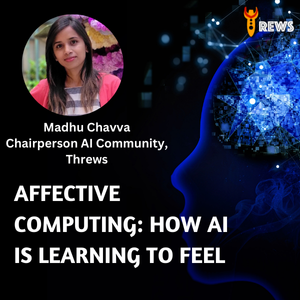Artificial Intelligence (AI) has made tremendous progress in fields like machine learning, natural language processing (NLP), and computer vision. But one of the most groundbreaking advancements is in affective computing — the ability of AI to understand and respond to human emotions.
Affective computing is transforming how we interact with machines, making them more human-like and emotionally aware. From virtual assistants adjusting their tone based on your mood to AI-powered healthcare systems detecting stress and anxiety, affective computing is changing the way technology engages with people.
In this blog, we’ll explore how affective computing works, its key applications, and the challenges AI faces in truly understanding human emotions.
What is Affective Computing?
Affective computing refers to the ability of machines to detect, interpret, and respond to human emotions. The term was introduced by Rosalind Picard in her book “Affective Computing” (1997).
The goal of affective computing is to enable machines to develop emotional intelligence, allowing them to interact with humans in a more natural and personal way. AI systems use various data sources to recognize emotions, such as:
- Facial expressions – AI analyzes smiles, frowns, and other expressions.
- Voice tone – Changes in pitch, tone, and volume help AI detect emotional states.
- Body language – Posture and gestures can reflect emotional states.
- Text sentiment – AI uses natural language processing (NLP) to understand emotional tone.
- Physiological signals – Heart rate, breathing patterns, and skin conductivity offer insights into emotional states.
Affective computing combines elements of psychology, cognitive science, and machine learning to help AI engage with humans more effectively.
How Affective Computing Works
AI systems use machine learning models and data analysis techniques to detect and respond to emotional signals. Here’s how affective computing functions in real-life scenarios:
1. Facial Expression Analysis
AI uses computer vision to analyze facial expressions and identify emotional cues.
- A smile → Happiness
- Raised eyebrows → Surprise
- Furrowed brows → Confusion or anger
- Drooping eyes → Sadness or fatigue
Machine learning models are trained on thousands of facial images to recognize patterns and link them to emotional states.
Example: AI-based customer service systems can detect a frustrated expression and offer to escalate the issue to a human agent.
2. Voice and Speech Recognition
AI analyzes variations in speech patterns, including:
- Pitch – High or low tone can reflect excitement or sadness.
- Tone – A sharp tone may indicate frustration or anger.
- Volume – A loud voice might signal urgency or stress.
- Pauses – Hesitation or silence can indicate uncertainty.
AI systems adjust their responses based on these patterns, making conversations feel more natural.
Example: Virtual assistants like Siri and Alexa modify their tone and responses based on the user’s emotional state.
3. Text Sentiment Analysis
AI-powered sentiment analysis detects emotional tone in written text using natural language processing (NLP).
- Positive language – “I’m so happy today!”
- Negative language – “I feel terrible right now.”
- Neutral language – “It’s just another day.”
AI evaluates the context, choice of words, and even the use of emojis to detect emotional intent.
Example: Social media platforms use sentiment analysis to track how users respond to trending topics.
4. Body Language Recognition
AI uses motion sensors and computer vision to analyze posture and movement.
- Crossed arms → Defensiveness or discomfort
- Open posture → Confidence and relaxation
- Fidgeting → Nervousness or anxiety
Example: Healthcare providers use AI to monitor patient body language to identify emotional distress or discomfort.
5. Physiological Data Monitoring
AI can analyze biological signals to detect emotional states.
- Heart rate – Increased heart rate signals stress or excitement.
- Skin conductivity – Sweating may reflect nervousness.
- Breathing patterns – Shallow or rapid breathing can signal anxiety.
Example: Fitness trackers use AI to recommend relaxation exercises when stress levels are high.
Applications of Affective Computing
Affective computing is being applied across multiple industries to improve user experiences and make systems more responsive to human needs:
1. Healthcare
- AI-based mental health apps like Woebot provide emotional support by engaging in natural conversations.
- AI in therapy sessions can monitor patient stress levels and emotional responses.
2. Customer Service
- AI chatbots detect customer frustration through tone and language, escalating issues when necessary.
- Emotionally aware systems can provide more personalized customer experiences.
3. Education
- AI-based learning platforms adapt to student frustration or confusion.
- AI systems modify lesson plans based on a student’s emotional engagement.
4. Entertainment
- AI in video games adjusts game difficulty based on player frustration or boredom.
- Streaming platforms recommend content based on emotional patterns.
5. Autonomous Vehicles
- AI monitors driver fatigue and stress levels through facial recognition and eye tracking.
- Systems suggest breaks or switch to autopilot when signs of fatigue are detected.
6. Smart Home Technology
- AI in smart home devices detects emotional states through voice tone and behavior.
- Smart lighting, music, and temperature can adjust based on mood.
Challenges and Limitations
While affective computing has made significant progress, it still faces several challenges:
1. Cultural Differences
Emotional expressions vary across cultures, making it difficult for AI to interpret emotions accurately on a global scale.
2. Privacy Concerns
AI systems require access to sensitive personal data like facial images and voice recordings, raising privacy and security concerns.
3. Emotional Complexity
Human emotions are layered and sometimes contradictory. AI can struggle to differentiate between sarcasm, humor, and genuine emotion.
4. Ethical Concerns
AI’s ability to manipulate emotions raises concerns about misuse in advertising, political influence, and social control.

